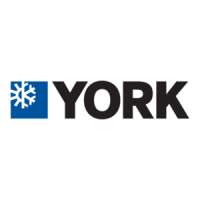FORM 150.40-NM20
13
YORK INTERNATIONAL
A 4-digit display (See Fig. 4) allows the operator to se-
lect and display system operating parameters via two
“Select Data Display” rotary switches. These parameters
are:
• Return Chilled Water Temperature
• Leaving Chilled Water Temperature
• Low Leaving Water Cutout Temperature
• Return Chilled Water Setpoint
• % Full Load Motor Current
• Suction Pressure
• Oil Pressure, PSID
• Discharge Pressure
• Suction Pressure Cutout Setting, PSIG
• Water Cooling Range Temperature
(Also see Fig. 5 for a complete list)
The system “Return Chilled Water Temp” is entered by
two rotary switches and the “Water Cooling Range” by
a single rotary switch.
The compressor can be activated by the “SYS” toggle
switch. The switch normally remains “ON” after startup.
Remote cycling and Return Chilled Water Temp Setpoint
Reset can be accomplished as noted on Page 18. Load-
ing and unloading decision making is done by software
on the Micro Logic Board. These decisions are made
according to temperature deviations from the selected
setpoint and the selected cooling range resulting in more
precise control of water temperature.
CONTROL PANEL
1. “CHILLED WATER TEMP SELECT”*
Control is achieved by Return Chilled Water
Setpoint (adjustable from 0°F to 70°F in one de-
gree increments). Setpoint is entered via two ro-
tary switches on the control panel marked “Chilled
Water Temp. Select °F”.
*If needed, the unit can be configured to control
Leaving Chilled Water Temp. This can be accom-
plished by a jumper/switch on the Micro Board. See
Fig. 11 & 12.
J10 OUT/SW. 3 OFF RWT Control
J10 IN/SW.3 ON LWT Control
NOTE: It is recommended that RWT control be used
unless LWT control is absolutely necessary.
2. “WATER COOLING RANGE” Select Switch
Temperature control range is variable via a single ro-
tary switch labeled “Water Cooling Range”. There will
be a choice of eight settings (0-7). Available ranges
are 6.0°F, 7.0°F, 8.0°F, 9.0°F, 10.0°F, 11.0°F, 12.0°F,
and 14.0°F, corresponding to setting 0-7 respectively.
3. SYS “ON/OFF” Switch
The switch allows the operator to manually turn off
the system. To operate the system, the switch must
be in the “ON” position.
4. “DATA DISPLAY CODES”
Refer to this list when selecting the desired sys-
tem parameter to be displayed. A list of the codes
and their respective number is shown in Fig. 5.
5. “UNIT START-UP SEQUENCE”
This is a simplified start-up procedure for switch
setup of the panel and system.
6. “SYSTEM MONITORING OR DIAGNOSIS”
This list informs the operator of the meaning of the
alphabetic codes which may appear on the display.
Anti-recycle status, external device status, and fault
information is displayed using this alphabetical
code. (See Fig. 4 and 5.)
7. “FAULT CODES”
Any time an “F” appears on the display, the com-
pressor will be shut down on a safety control. At
this time, the operator should turn the “SELECT
DATA DISPLAY” rotary switches to the number
“18”. When this is done, a Fault Code will appear
which can be compared to the “FAULT Code” list
to determine the reason for system failure. A list
of the codes and their respective number is shown
in Fig. 5.
An “F” Code overrides any other letter code dis-
play which may appear. See the “SHUTDOWN
SAFETY CONTROLS” and “MANUAL RESET
SAFETY CONTROLS” Section for a more detailed
explanation of the codes.
8. “WATER COOLING RANGE CODE”
Refer to this list when setting up the “WATER
COOLING RANGE” rotary switch. Since the switch
does not read directly, decoding is necessary.
9. “SELECT DATA DISPLAY” Switches
These switches can be used to display 18 Test
Points for troubleshooting and data recording. This
is done via the 2 Rotary Switches marked “Select
Data Display”. To look at a specific function, select
the number of the function from the “Data Display
Codes” listing on the panel.
Proceed by dialing the number up on the “Select
Data Display” Rotary Switches. In the event of a fail-
ure, the failure can be displayed by selecting #18 of
the “Select Data Display”. The mode of failure will
then be indicated by a number from 0-11. This num-
ber can be translated by comparing the number to
the “Fault Code” listing on the right side of the panel.
(YCHA100)

